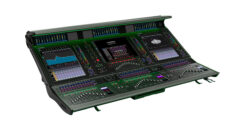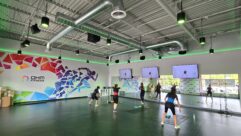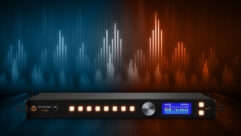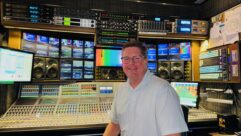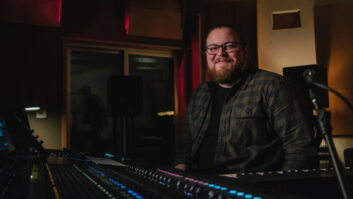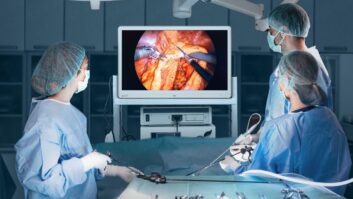Individual audio system needs will depend a lot on the application, of course. So we’ve rounded up a selection of some of the latest consoles and processors that cover a range of live and installed sound projects where ease of use, customization, and reliability are key.

With a 96kHz XCVI FPGA engine, Allen & Heath’s SQ Series Digital Mixers bring the high-resolution audio performance of the dLive Digital Mixing System to a compact, cost-effective, multi-application platform. Two models offer a choice of size and control configuration. The rack-mountable SQ-5 has 16 onboard preamps, 17 faders, and 8 softkeys; the SQ-6 provides 24 preamps, 25 faders, 4 assignable rotary controls, and 16 softkeys. Both models support up to 56 input channels via remote expanders and both feature a networking slot for optional Dante, Waves, and other cards. An ecosystem of apps, remote expanders, networking cards, and personal mixers multiplies SQ expansion and integration possibilities. The new SLink intelligent port allows connection to Allen & Heath’s 96kHz and 48kHz expanders and can link to another SQ mixer, a Qu Series mixer or a dLive system.

The AMX Alero ALR-AEC-8 is a dedicated microphone mixer for up to eight microphones used for conferencing apps such as Lync or Skype in medium to large meeting rooms. It also supports VTC and audio conferencing systems. A USB audio output enables the Alero ALR-AEC-8 to be a microphone expansion unit for Enzo or PC-Based web conferencing applications, while an onboard web configuration tool allows for simple setup and configuration for users of any experience level, with no PC software required. The active adjustment of audio levels and settings means great audio quality without users having to make manual adjustments. Additionally, acoustic echo cancellation helps eliminate echo feedback during web and audio conferences.

The Ashly Audio digiMIX18 digital mixer features intuitive real-time mixing functionality pros and beginners will appreciate, with real buttons and knobs, intelligent fader and meter bridge, and a seven-inch touchscreen interface. A free iPad app is also available for remote control. Providing flexibility and realworld tools, it’s also easy for new users to navigate basic functions in EZMode. Additional features include 18 inputs, 12 output busses, comprehensive equalization and dynamics processing, two effects engines, auto-mixing functionality, optional Dante digital connectivity, and supplied rack-mounting hardware for a locking rack system.

The Audio-Technica ATDM-0604 is a six-channel automatic mixer ideal for meetings, conferences, courtroom proceedings, and other applications involving the use of multiple microphones or other media inputs. AudioTechnica’s SmartMixer technology allows channels to be mixed automatically in gate or gain sharing mode, ensuring consistent, high-quality audio output from all inputs in a setup. Controls and LED indicators on the mixer’s front panel allow users to easily adjust input/output and gain levels; set and recall presets; turn on/off phantom power, low-cut filter, automatic mixing and acoustic echo cancellation; change IP configuration; and more. A full complement of digital signal processing is available for inputs and outputs, including parametric EQ, compressor, limiter, and feedback control. Control and monitoring tools are accessible locally on the front panel or via the Web Remote interface, which allows users to handle the adjustments from a Windows-based PC, Mac, iOS or Android device, plus make additional changes to settings.

The TesiraFORTÉ DAN audio processors are the collaborative result between Biamp and Shure. Offered in the same four fixed I/O models as the original TesiraFORTÉ family (AI, CI, TI, and VI) with the addition of 32×32 channels of audio via the Dante Brooklyn II module. All models are standard with 12 mic/line inputs, eight line outputs, Ethernet control, RS-232, USB audio with up to eight channels of configurable audio, four general purpose I/Os, and an OLED display. The TesiraFORTÉ DAN VI, TI, and CI models feature Biamp’s AEC technology to eliminate acoustic echoes and feedback for a clear, natural-sounding audio experience. Along with the new dedicated Shure MXA input blocks in the latest Tesira 3.0 software, these new processors deliver seamless interoperability between the most advanced DSP and microphone technologies.

The Bosch PLM-8M8 PLENA matrix 8-channel DSP mixer from Bosch Security Systems connects to PLM8CS call stations, PLMWCP wall control panels, and the PLM4Px2x amplifiers to create up to eight zones for speech and background music. It features four microphone/ line, 3 music source, call station and emergency inputs, and 8 independent output zones and Amp Link outputs. Managed through PC GUI or an iOS app via iPhone or iPad, the unit has input gain, compression, EQ, output delays, and both zone and global system muting. Drag-and-drop makes the copying of these parameters to other zones very quick and easy. The PLM8CS call station and PLMWCP wall control panel can be connected in series using RS485.

Extending the ToneMatch audio engine series, the eight-channel Bose T8S ToneMatch mixer is compact and portable, with rugged enclosures that have a protective, magnetically-coupled cover to protect controls and connectors. A chassis-bottom insert allows the use of standard mounting accessories. It is intuitive to operate, with illuminated tactile controls, an easy-to-read display, and scene recall. When used with Bose L1 and F1 systems, the T8S provides full endto-end tonal optimization. Each T8S channel has dedicated ToneMatch, EQ, dynamics, and effects. T8S effects includes compressor, limiter, de-esser, noise gate, chorus, flanger, phaser, tremolo, delay, and reverb functions. The T8S features eight audio preamps with XLR-combo jacks, with switchable phantom power. Two aux inputs allow for additional source inputs. Outputs include four aux sends, balanced quarter-inch TRS and XLR stereo outputs, and an independent headphone output.

The Cadac CDC seven-s is the new flagship console in Cadac’s digital lineup, taking the original CDC seven a step further by expanding the input count to 128 and the configurable output count to 56. The CDC seven-s is physically larger than its sister consoles, the CDC six and five, and also has that greater channel count. But it shares the same operating system and feature set as its smaller siblings, meaning that show files can run across all three. Additionally, Cadac designed its own audio protocol, MegaCOMMS, which is a digital audio network that allows the CDC seven-s to have a total through-system propagation delay from inputs on stage to outputs, including all console processing and AD/DA conversions, of 37 samples (@ 96 kHz), or just under 400us.

The two most recent additions to the ClearOne CONVERGE Pro 2 lineup, the 48V and the 012, are DSP mixers for conferencing and sound reinforcement applications of all sizes. The CONVERGE Pro 2 48V provides four mic/line inputs with ClearOne’s acoustic echo cancellation technology, eight mic/line outputs, and a VoIP interface with two default phone lines, plus three more available through a software upgrade. The 48V is Cisco and Avaya certified, with a native interface for Skype for Business. The CONVERGE Pro 2012 is a 12-mic-line outputs-only DSP mixer, providing the option of increased outputs when required. It creates a neat, economical solution to what might otherwise require a more expensive design.

The XD-16 and XD-28 digital mixers from Crest Audio are small format, 2U rackmount mixers available in either 16- or 28-channel frames. XD Series digital mixers offer optional Dante networking as well as real-time remote control and monitoring from any Android, Windows, or iOS device. The range of configurations available enables use as a simple FoH mixer, a monitor mixer, a personal monitor mixer, or a combination of all three. An integrated WiFi module enables real-time control and monitoring of the mixer processing functions, either by acting as a WiFi router for direct connection of up to four external devices for remote control, or alternatively by connecting to an external WiFi network. The optional 4×4 Dante network module allows up to eight channels (4-in/4- out) of audio streaming over a Dante network, and also extends the physical inputs of the XD-16/XD-28 by four aux channels, and also adds four outputs. Control is provided via the Dante Controller application.

The d&b audiotechnik DS10 Audio Network Bridge enables distribution of ethernet control data, and it connects Dante networks and AES3 digital audio signals. Up to 16 Dante network channels can be provided via AES3 digital signal outputs conveying metadata with Dante channel labels and cabling information to the 4-channel d&b amplifiers, and there are four AES3 input channels as well. The unit handles a primary and a secondary redundant Dante network on a fiveport switch and it has Multicast Filtering and VLAN modes. A laptop can control d&b amplifiers using the R1 remote control software.

At the heart of DiGiCo’s 4REA4 installed audio solution is the 4REA4 processing engine with DiGiCo connectivity options and 4REA4 control software, providing routing, processing, and mix control that allows your performance area to expand across your installation. The 4REA4 processing engine rack has four dedicated mix areas, or zones, each with its own stereo master output, CGs, and allocated FX. With an available 128 input channels and 48 buss output processing strips, you can independently allocate processing to whichever area as required. Managing the mixing and routing of each individual local performance area are a range of hardware control panels and external I/O units that work in conjunction with the 4REA4 processing engine and control software. Ethernet connected controller options include the wall mounting single rotary ACONTROL1 with a TFT display for small area performance management, and the ACONTROL8 with eight 100m faders designed for more complex mix and function control.

The Electro-Voice N8000 NetMax 300 MIPS digital matrix controller delivers full IRIS-Net supervision, control, and scheduling along with up to 32 input channels, extensive DSP, and CobraNet audio and control connections. It offers support for ethernet, RS-232, USB, and CAN, and Dante audio networking options are available. Four slots with 8-channel audio modules form the foundation for flexible customization, and each slot can house input or output cards. It includes internal 48-bit processing, and the auto-compiling DSP engine has ultra-low fixed latency. One time or regularly scheduled events can be arranged and reactions to certain events or system states can be configured. Any system problems can be detected automatically and can be displayed on the PC screen or transmitted to external sites.

The Extron AXI 016 is a 16-output audio expansion interface for DMP 128 Plus audio DSP systems. The AXI 016 connects to the EXP expansion port on the DMP 128 Plus, transforming the matrix from an 8-output device into a 24-output device. Since all of the high performance, low-latency DSP processing occurs within the attached DMP 128 Plus, no separate configuration is needed for the AXI 016. The AXI 016 audio expansion interface also supports audio DSP systems that integrate a DMP 128 Plus and a DTP CrossPoint matrix switcher. The DMP 128 Plus features an extensive mix matrix allowing all outputs, including the 16 expansion bus outputs used by the AXI 016, to be discreetly sourced and routed from any input. When used with the DMP 128 Plus AT, Dante audio sources can also be processed and routed to the outputs of the AXI 016.

Lectrosonics had versatility in mind when it developed the Aspen SPN2412, with its 24 inputs and 12 outputs, which can be expanded to many more. The Proportional Gain Algorithm allows it to work seamlessly with other sound gear, while data, audio, and control signals are carried through a single Cat-6 cable. Setup is aided by automatic master/slave detection and its automatic mixing parameters and presets are extensive including multizone mix minus configuration. The Phantom Mix mode lets the mixing come from multiple zones and fed back into only those zones that are selected for the feed. And with TCP/IP addressability for control through ethernet, it can be part of your network.

The 32-channel Mackie DL32R is built road-tough, and its Onyx+ mic pres deliver clear sound to the mixer’s 14 assignable XLR outputs, stereo AES, phones out, and 1/4in. monitor output. The DL Dante expansion card provides an optional 32×32 channels of networked audio. The DL32R is based on the Mackie AXIS Digital Mixing System, and the Master Fader control app allows wireless control with View Groups, overview, user definable presets, and mic preamp view. Sophisticated DSP and 32 track recording to disk, computer or any Dante-equipped recording device provide plenty of creative power. The DL32R features flexible I/O in a compact design, so you can place it anywhere.

The Presonus StudioLive 32 digital console/recorder is fully recallable, with 33 touch-sensitive, motorized faders and 33 recallable XMAX preamps. It includes Fat Channel processing, re-engineered from the ground up, and vintage-style EQs and compressors. Built-in AVB networking, onboard multitrack Capture recording to SD Card, and a complete suite of software is also standard. The PreSonus Capture recording software is an intuitive, multitrack recording application with virtual soundcheck. The one-touch recording makes it easy to record to the StudioLive 32’s onboard SD multitrack recorder, and when you’re finished recording, open the Capture session in Studio One Professional for Mac and Windows (included), and the entire mix scene will transfer to the Studio One session, including fader levels and Fat Channel setting.

Taking small-format mixing to the next level, QSC has introduced Version 3.0 for the TouchMix-8 and -16 Series. The new firmware is available as a free download for current users and will be factory-installed in new production units going forward. Version 3.0 includes many enhancements, including features previously available exclusively on the Series’ TouchMix-30 Pro, such as Anti-Feedback and Room-Tuning Wizards, Real-Time Analyzer (RTA), Copy-and-Paste, playback of MP3 files on a USB drive, Input Delay, Output PEQ, 15 dB Digital Gain, Channel Overview, USB Drive Formatting, and improved graphics and screen layout. Additional enhancements include Channel Safe, Tap Tempo, Tablet Follows Mixer, additional User Buttons (on connected tablet), and the ability to configure Aux 7/8 and Aux 9/10 as balanced, mono outputs (TouchMix-16). QSC loudspeaker tunings are also present in Version 3.0, including presets for the K.2 Series.

The RCF MZ8060 is a versatile 8×6 digital audio matrix mixer built on the foundation of RCF’s RDNet DSP platform. RDNet is a proprietary protocol for RCF loudspeaker products that provides dedicated networking software that makes is possible to control and monitor all system components and parameters. The DSP allows for configurable system programming including room combining, automatic level control, along with all audio input and output criteria including EQs, gates, compressors, limiters, delays, priorities, and levels. The MX8060 features eight universal mic/ line inputs with six balanced outputs along with 10 programmable logic inputs and six programmable logic outputs. It features eights universal mic/ line inputs with 48V phantom power and full audio processing, six hi-level routable balanced outputs with full audio processing, 10 programmable logic inputs (GPI), and six programmable logic outputs (GPO).

The M-5000 Series mixing consoles from Roland apply its OHRCA (Open High Resolution Configurable Architecture) to provide 128 freely definable audio paths. The mixers have expansion modules for Dante, MADI, Waves Soundgrid, REAC, XI-SDI, XI- SFP, and XI-DVI. Its patchbays can accommodate hundreds of input/output channels enabling any input to be routed to a range of outputs without using a mixing channel. The M-5000 has 24 plus 4 faders while the slightly smaller M-5000C uses 16 plus 4 faders. The operation is focused on a bright 12in. touchscreen with 16 encoders having rings that change color according to their assigned functions.

The Shure IntelliMix P300 conferencing connects up to 10 Dante audio inputs, two analog inputs, a USB soft codec, and mobile device. Each input channel can be auto-mixed and provides acoustic echo cancellation, noise reduction, automatic gain control, matrix mixing, delay, compressor, and PEQ. An additional 3.5mm connection enables attendees to join by tablet or phone, and all this fits into a half-rack space package. It connects to room systems through two input and two output terminal blocks while its ethernet connection can use PoE to eliminate a separate power supply. Additionally, a predefined matrix and presets can simplify the setup process.

Soundcraft by HARMAN has introduced the Vi1000 digital mixing console, a 34in. x 32in. compliment to its two larger siblings, the Vi2000 and 3000. The Vi1000 employs Soundcraft’s Vistonics II channel strip user interface, as well as SpiderCore, a built-in DSP and I/O engine based on STUDER technology, offering 40-bit floating point processing. The Vi1000 features an additional remote-control surface for any of the larger consoles in the range, using their Mirroring feature. The Vi1000 comes with rear panel local I/O featuring 16 HQ mic/line inputs, 16 line outputs, and two 64-channel expansion slots that allow up to two MADI-based Stageboxes to be connected, or alternatively the slots provide access to an extensive range of D21m I/O option cards, that address all industry standard audio formats. Four channels of AES/EBU I/O plus USB and MIDI connections complete the back panel. The total I/O count of the console is 212 in x 212 out.

The Stage Tec AVATUS console controller provides TCP/IP connectivity for integration into a network. The surface consists of one large or several smaller modules, allowing, for example, a separate installation of the metering displays. The system supports remote network connections and browser-based mixing that requires no specific hardware. Every touchscreen gives full access to all configuration settings and central desk functions. The console integrates seamlessly into a NEXUS audio network that offers virtually unlimited audio-I/O resources in all common formats. The built-in macro controller allows for easy integration of external systems in any environment and for smooth day-to-day operations.

Symetrix Edge DSPs are equipped with 128 (64×64) redundant Dante channels. The Dante protocol enables reliable multi-channel audio networking over IP. Users can implement, control, and maintain a system of networked DSPs and accessories, including third party Dante-enabled microphones, loudspeakers, power amps, and mixing consoles. Four option card slots enable unique I/O configurations. Optional cards support analog and AES-3 digital I/O, as well as AEC, VoIP, and analog telephone. Edge is programmed using Symetrix’s Composer, an open-architecture CAD application that allows users to natively configure Symetrix and select third party Dante hardware, eliminating the confusion of multiple or redundant software applications. Multiple control options include Symetrix ARC wall panels and a SymVue Windows virtual GUI.

From TOA Electronics, the D-2000 Digital Mixing System consists of up to four D-2008SP frames, each of which can support up to 32 input channels using eight module slots, which can be connected to remote control units to suit the venue size. The D-2008SP can be linked via LAN to the D-2012C mixing console with 12 motorized faders and eight rotary encoders. A variety of analog and digital input and output modules make customization easy. The D-900 Remote Controller can operate up to 12 inputs and eight outputs through its connection to the D-984VC remote control module. Features include NOM automixing, feedback suppression, delay, high and low pass filters, gates, and many more DSP capabilities.

The core of the Yamaha RIVAGE PM7 digital mixing system includes the CSD-R7 digital mixing console, TWINLANe-based RPio622 and RPio222 I/O racks, and Dante-based Rio3224-D2 and Rio1608- D2 I/O racks. The CSD-R7 digital mixing console is the central component, the same size as the RIVAGE PM10 system CS-R10 control surface but with the DSP engine built into the console, offering enhanced portability and system flexibility. The panel layout of the PM7 is the same as the PM10, delivering the same user experience. With 120 input channels, 60 mix buses, 24 matrices, and a comprehensive selection of 48 plug-ins, the PM7 provides mixing capacity that is comparable to the PM10. A Dual Console function also allows the CSD-R7 to be connected to one of the PM10 system control surfaces. The CSD-R7 offers connectivity with two types of audio networks, allowing either or both to be used for connection and control of I/O rack units. The TWINLANe network uses optical cable to handle up 400 channels of audio, and combinations of the RPio622 and/or RPio222 I/O racks and HY256-TL or HY256-TL-SMF audio interface cards allow input via Hybrid Microphone Preamplifiers with analog input stages.


